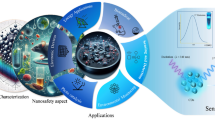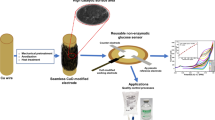Abstract
3-Hydroxybutyrate, one of the main blood ketone bodies, has been considered as a critical indicator for diagnosis of diabetic ketoacidosis. Biosensors designed for detection of 3-hydroxybutyrate with advantages of precision, easiness and speedy performance have attracted increasing attention. This study attempted to develop a 3-hydroxybutyrate dehydrogenase-based biosensor in which single-walled carbon nanotubes (SWCNT) was used in order to immobilize the cofactor, NAD+, on the surface of screen-printed electrode. The formation of NAD+–SWCNT conjugates was assessed by electrochemistry and electron microscopy. Cyclic voltammetry was used to analyze the performance of this biosensor electrochemically. The considerable shelf life and reliability of the proposed biosensor to analyze real sample was confirmed by this method. The reduction in the over potential of electrochemical oxidation of NADH to −0.15 V can be mentioned as a prominent feature of this biosensor. This biosensor can detect 3-hydroxybutyrate in the linear range of 0.01–0.1 mM with the low detection limit of 0.009 mM. Simultaneous application of screen-printed electrode and SWCNT has made the biosensor distinguished which can open new prospects for detection of other clinically significant metabolites.







Similar content being viewed by others
References
Adam V, Kizek R (2008) Utilization of electrochemical sensors and biosensors in biochemistry and molecular biology. Sensors 8(10):6125–6131
Clark LC, Lyons C (1962) Electrode systems for continuous monitoring in cardiovascular surgery. Ann N Y Acad Sci 102(1):29–45. doi:10.1111/j.1749-6632.1962.tb13623.x
Wang Y, Xu H, Zhang J, Li G (2008) Electrochemical sensors for clinic analysis. Sensors 8(4):2043–2081
Wallace TM, Matthews DR (2004) Recent advances in the monitoring and management of diabetic ketoacidosis. QJM 97(12):773–780. doi:10.1093/qjmed/hch132
Laffel L (1999) Ketone bodies: a review of physiology, pathophysiology and application of monitoring to diabetes. Diabetes Metab Res Rev 15(6):412–426
Kiba N, Saegusa K, Furusawa M (1997) Post-column enzyme reactors for chemiluminometric detection of glucose, 1,5-anhydroglucitol and 3-hydroxybutyrate in an anion-exchange chromatographic system. J Chromatogr B Biomed Sci Appl 689(2):393–398
Kimura M, Kobayashi K, Matsuoka A, Hayashi K, Kimura Y (1985) Head-space gas-chromatographic determination of 3-hydroxybutyrate in plasma after enzymic reactions, and the relationship among the three ketone bodies. Clin Chem 31(4):596–598
Tabata M, Totani M (1995) A chemiluminescence-flow injection analysis of serum 3-hydroxybutyrate using a bioreactor consisting of 3-hydroxybutyrate dehydrogenase and NADH oxidase. Anal Biochem 229(1):133–138
Forrow NJ, Sanghera GS, Walters SJ, Watkin JL (2005) Development of a commercial amperometric biosensor electrode for the ketone d-3-hydroxybutyrate. Biosens Bioelectron 20(8):1617–1625
Kwan RCH, Hon PYT, Mak WC, Law LY, Hu J, Renneberg R (2006) Biosensor for rapid determination of 3-hydroxybutyrate using bienzyme system. Biosens Bioelectron 21(7):1101–1106
Li G, Ma NZ, Wang Y (2005) A new handheld biosensor for monitoring blood ketones. Sens Actuat B Chem 109(2):285–290
Fang L, Wang S-H, Liu C-C (2008) An electrochemical biosensor of the ketone 3-[beta]-hydroxybutyrate for potential diabetic patient management. Sens Actuat B Chem 129(2):818–825
Zhou J-L, Nie P-P, Zheng H-T, Zhang J-M (2009) Progress of electrochemical biosensors based on nicotinamide adenine dinucleotide (phosphate)-dependent dehydrogenases. Chin J Anal Chem 37(4):617–623
Lobo MJ, Miranda AJ, Tuñón P (1997) Amperometric biosensors based on NAD(P)-dependent dehydrogenase enzymes. Electroanalysis 9(3):191–202. doi:10.1002/elan.1140090302
Omidfar K, Kia S, Kashanian S, Paknejad M, Besharatie A, Kashanian S, Larijani B (2010) Colloidal nanogold-based immunochromatographic strip test for the detection of digoxin toxicity. Appl Biochem Biotechnol 160(3):843–855. doi:10.1007/s12010-009-8535-x
Hyun S, Park TH (2011) Integration of biomolecules and nanomaterials: towards highly selective and sensitive biosensors. Biotechnol J 6(11):1310–1316. doi:10.1002/biot.201100006
Omidfar K, Dehdast A, Zarei H, Sourkohi BK, Larijani B (2011) Development of urinary albumin immunosensor based on colloidal AuNP and PVA. Biosens Bioelectron 26(10):4177–4183
Omidfar K, Zarei H, Gholizadeh F, Larijani B (2012) A high-sensitivity electrochemical immunosensor based on mobile crystalline material-41–polyvinyl alcohol nanocomposite and colloidal gold nanoparticles. Anal Biochem 421:649–656
Endo M, Strano M, Ajayan P (2008) Potential applications of carbon nanotubes. in: carbon nanotubes, vol 111. Topics in applied physics. Springer, Berlin/Heidelberg, pp 13–61. doi:10.1007/978-3-540-72865-8_2
Jeykumari DRS, Narayanan SS (2008) Fabrication of bienzyme nanobiocomposite electrode using functionalized carbon nanotubes for biosensing applications. Biosens Bioelectron 23(11):1686–1693
Xue C-H, Zhou R-J, Shi M-M, Wu G, Zhang X-B, Wang M, Chen H-Z (2010) Electrochemistry of glucose oxidase immobilized on carbon nanotubes noncovalently functionalized by multihydroxyl and multicarboxyl groups. J Electroanal Chem 642:92–97
Gao Y, Kyratzis I (2008) Covalent immobilization of proteins on carbon nanotubes using the cross-linker 1-ethyl-3-(3-dimethylaminopropyl)carbodiimide—a critical assessment. Bioconjug Chem 19(10):1945–1950. doi:10.1021/bc800051c
Kim J, Grate JW, Wang P (2006) Nanostructures for enzyme stabilization. Chem Eng Sci 61(3):1017–1026
Hart JP, Crew A, Crouch E, Honeychurch KC, Pemberton RM (2005) Some recent designs and developments of screen printed carbon electrochemical sensors/biosensors for biomedical, environmental, and industrial analyses. Anal Lett 37(5):789–830. doi:10.1081/al-120030682
Fanjul-Bolado P, Queipo P, Lamas-Ardisana PJ, Costa-García A (2007) Manufacture and evaluation of carbon nanotube modified screen-printed electrodes as electrochemical tools. Talanta 74(3):427–433
Sharma MK, Agarwal GS, Rao VK, Upadhyay S, Merwyn S, Gopalan N, Rai GP, Vijayaraghavan R, Prakash S (2010) Amperometric immunosensor based on gold nanoparticles/alumina sol-gel modified screen-printed electrodes for antibodies to Plasmodium falciparum histidine rich protein-2. Analyst 135(3):608–614
Silva Nunes G, Jeanty G, Marty J-L (2004) Enzyme immobilization procedures on screen-printed electrodes used for the detection of anticholinesterase pesticides: comparative study. Anal Chim Acta 523(1):107–115
Pellicer C, Gomez-Caballero A, Unceta N, Goicolea MA, Barrio RJ (2010) Using a portable device based on a screen-printed sensor modified with a molecularly imprinted polymer for the determination of the insecticide fenitrothion in forest samples. Anal Methods 2(9):1280–1285
Khorsand F, Riahi S, Eynollahi Fard S, Kashanian S, Naeemy A, Larijani B, Omidfar K Development of 3-hydroxybutyrate dehydrogenase enzyme biosensor based on carbon nanotube modified screen-printed electrode. IET Nanobiotechnol (in press)
Omidfar K, Rasaee MJ, Zaraee AB, Amir MP, Rahbarizadeh F (2002) Stabilization of penicillinase-hapten conjugate for enzyme immunoassay. J Immunoassay Immunochem 23(3):385–398. doi:10.1081/ias-120013035
Osorio AG, Silveira ICL, Bueno VL, Bergmann CP (2008) H2SO4/HNO3/HCl-functionalization and its effect on dispersion of carbon nanotubes in aqueous media. Appl Surf Sci 255(5):2485–2489. doi:10.1016/j.apsusc.2008.07.144
Chakraborty S, Raj CR (2007) Mediated electrocatalytic oxidation of bioanalytes and biosensing of glutamate using functionalized multiwall carbon nanotubes–biopolymer nanocomposite. Electroanal Chem 609(2):155–162
Kim UJ, Furtado CA, Liu X, Chen G, Eklund PC (2005) Raman and IR spectroscopy of chemically processed single-walled carbon nanotubes. J Am Chem Soc 127(44):15437–15445. doi:10.1021/ja052951o
Kumar S, Chen S-M (2008) Electroanalysis of NADH using conducting and redox active polymer/carbon nanotubes modified electrodes—a review. Sensors 8(2):739–766
Zhou H, Zhang Z, Yu P, Su L, Ohsaka T, Mao L (2010) Noncovalent attachment of NAD+ cofactor onto carbon nanotubes for preparation of integrated dehydrogenase-based electrochemical biosensors. Langmuir 26(8):6028–6032. doi:10.1021/la903799n
Wang XS, Liu P, Zheng HT, Hu H, Zheng WJ, Suye SI (2011) Preparation of nicotinamide adenine dinucleotide functionalized multi-walled carbon nanotube and its application to dehydrogenase biosensor. Adv Mater Res 298:121–127
Wu B-Y, Hou S-H, Yin F, Zhao Z-X, Wang Y-Y, Wang X-S, Chen Q (2007) Amperometric glucose biosensor based on multilayer films via layer-by-layer self-assembly of multi-wall carbon nanotubes, gold nanoparticles and glucose oxidase on the Pt electrode. Biosens Bioelectron 22(12):2854–2860
Zhang M, Smith A, Gorski W (2004) Carbon nanotube–chitosan system for electrochemical sensing based on dehydrogenase enzymes. Anal Chem 76(17):5045–5050. doi:10.1021/ac049519u
Xu Z, Gao N, Chen H, Dong S (2005) Biopolymer and carbon nanotubes interface prepared by self-assembly for studying the electrochemistry of microperoxidase-11. Langmuir 21(23):10808–10813. doi:10.1021/la051445+
Zhang R, Wang X, Shiu K-K (2007) Accelerated direct electrochemistry of hemoglobin based on hemoglobin–carbon nanotube (Hb–CNT) assembly. J Colloid Interface Sci 316(2):517–522
Musameh M, Wang J, Merkoci A, Lin Y (2002) Low-potential stable NADH detection at carbon-nanotube-modified glassy carbon electrodes. Electrochem Commun 4(10):743–746
Wooten M, Gorski W (2010) Facilitation of NADH electro-oxidation at treated carbon nanotubes. Anal Chem 82(4):1299–1304. doi:10.1021/ac902301b
Acknowledgments
This research was supported by a grant from Endocrinology and Metabolism Research Center of Tehran University of Medical Sciences, Tehran, I.R. Iran.
Author information
Authors and Affiliations
Corresponding author
Rights and permissions
About this article
Cite this article
Khorsand, F., Darziani Azizi, M., Naeemy, A. et al. An electrochemical biosensor for 3-hydroxybutyrate detection based on screen-printed electrode modified by coenzyme functionalized carbon nanotubes. Mol Biol Rep 40, 2327–2334 (2013). https://doi.org/10.1007/s11033-012-2314-4
Received:
Accepted:
Published:
Issue Date:
DOI: https://doi.org/10.1007/s11033-012-2314-4




